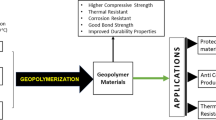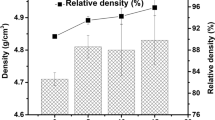Abstract
The agglomeration of nano particles in cement systems remains a major challenge for their wide use in construction materials. A method of preparing highly dispersed nano-SiO2 in cement paste is introduced in this paper, and the effects of modified nano-SiO2 (SiO2@PCE) with a core–shell structure on cement hydration and microstructure development were investigated by isothermal calorimetry, quantitative X-ray diffraction, thermogravimetric analysis, scanning electron microscopy and nanoindentation. The results show that well-dispersed nano-SiO2@PCE particles in a cement system can significantly accelerate cement hydration at an early age. The highly dispersed nano-SiO2@PCE particles refine the pore structure of the hardened cement paste. More specifically, the number of harmless and less-harmless pores is increased, whereas the number of harmful and more-harmful pores is reduced. In addition, the proportion of high-density C–S–H and low-density C–S–H in the hardened cement paste at an early age increases by 69% and decreases by 27%, respectively, with the addition of 1.5% nano-SiO2@PCE. Through the seeding effect, cement hydration is accelerated pronouncedly with the addition of highly dispersed SiO2@PCE nano particles. In addition, the stiffness of the paste is enhanced by the pozzolanic reaction between SiO2@PCE and portlandite.







Similar content being viewed by others
References
Pacheco-Torgal F, Jalali S (2011) Nanotechnology: advantages and drawbacks in the field of construction and building materials. Constr Build Mater 25:582–590
Sanchez F, Sobolev K (2010) Nanotechnology in concrete—a review. Constr Build Mater 24:2060–2071
Singh LP, Karade SR, Bhattacharyya SK, Yousuf MM, Ahalawat S (2013) Beneficial role of nanosilica in cement based materials—a review. Constr Build Mater 47:1069–1077
Luo Z, Li W, Tam VWY, Xiao J, Shah SP (2019) Current progress on nanotechnology application in recycled aggregate concrete. J Sustain Cem Based Mater 8:79–96
Said AM, Zeidan MS, Bassuoni MT, Tian Y (2012) Properties of concrete incorporating nano-silica. Constr Build Mater 36:838–844
Nazari A, Riahi S, Riahi S, Shamekhi SF, Khademno A (2009) Mechanical properties of cement mortar with Al2O3 nanoparticles. J Am Sci 5:94–97
Lee BY, Jayapalan AR, Kurtis KE (2013) Effects of nano-TiO2 on properties of cement-based materials. Mag Concr Res 65:1293–1302
Pan Z, He L, Qiu L, Korayem AH, Li G, Zhu JW, Collins F, Li D et al (2015) Mechanical properties and microstructure of a graphene oxide–cement composite. Cem Concr Comp 58:140–147
Hou P, Kawashima S, Kong D, Corr DJ, Qian J, Shah SP (2013) Modification effects of colloidal nanoSiO2 on cement hydration and its gel property. Compos B Eng 45:440–448
Li W, Huang Z, Cao F, Sun Z, Shah SP (2015) Effects of nano-silica and nano-limestone on flowability and mechanical properties of ultra-high-performance concrete matrix. Constr Build Mater 95:366–374
Li W, Long C, Tam VWY, Poon C-S, Hui Duan W (2017) Effects of nano-particles on failure process and microstructural properties of recycled aggregate concrete. Constr Build Mater 142:42–50
Jalal M, Mansouri E, Sharifipour M, Pouladkhan AR (2012) Mechanical, rheological, durability and microstructural properties of high performance self-compacting concrete containing SiO2 micro and nanoparticles. Mater Des 34:389–400
Jo B-W, Kim C-H, Tae G-h, Park J-B (2007) Characteristics of cement mortar with nano-SiO2 particles. Constr Build Mater 21:1351–1355
Land G, Stephan D (2011) The influence of nano-silica on the hydration of ordinary Portland cement. J Mater Sci 47:1011–1017
Senff L, Labrincha JA, Ferreira VM, Hotza D, Repette WL (2009) Effect of nano-silica on rheology and fresh properties of cement pastes and mortars. Constr Build Mater 23:2487–2491
Wang L, Zheng D, Zhang S, Cui H, Li D (2016) Effect of nano-SiO2 on the hydration and microstructure of portland cement. Nanomaterials 6:241–256
Li W, Luo Z, Long C, Huang Z, Huang L, Yu Q, Sun Z (2018) Mechanical strengths and microstructures of recycled aggregate concrete incorporating nanoparticles. Adv Civil Eng Mater 7:188–205
Rong Z, Sun W, Xiao H, Jiang G (2015) Effects of nano-SiO2 particles on the mechanical and microstructural properties of ultra-high performance cementitious composites. Cem Concr Comp 56:25–31
Rupasinghe M, San Nicolas R, Mendis P, Sofi M, Ngo T (2017) Investigation of strength and hydration characteristics in nano-silica incorporated cement paste. Cem Concr Comp 80:17–30
Wang J, Du P, Zhou Z, Xu D, Xie N, Cheng X (2019) Effect of nano-silica on hydration, microstructure of alkali-activated slag. Constr Build Mater 220:110–118
Kong D, Corr DJ, Hou P, Yang Y, Shah SP (2015) Influence of colloidal silica sol on fresh cement properties as compared to silica power with agglometres in micro scale. Cem Concr Comp 63:30–41
Kong D, Du X, Wei S, Zhang H, Yang Y, Shah SP (2012) Influence of nano-silica agglomeration on microstructure and properties of the hardened cement-based materials. Constr Build Mater 37:707–715
Bagheri A, Parhizkar T, Madani H, Raisghasemi AM (2012) The influence of different preparation methods on the aggregation status of pyrogenic nanosilicas used in concrete. Mater Struct 46:135–143
Elkady H (2013) Effect of nano silica de-agglomeration, and methods of adding super-plasticizer on the compressive strength, and workability of nano silica concrete. Civil Env Res 3:21–34
Zhang M-H, Sisomphon K, Ng TS, Sun DJ (2010) Effect of superplasticizers on workability retention and initial setting time of cement pastes. Constr Build Mater 24:1700–1707
Burgos-Montes O, Palacios M, Rivilla P, Puertas F (2012) Compatibility between superplasticizer admixtures and cements with mineral additions. Constr Build Mater 31:300–309
Hanehara S, Yamada K (1999) Interaction between cement and chemical admixture from the point of cement hydration, absorption behaviour of admixture, and paste rheology. Cem Concr Res 29:1159–1165
Plank J, Sakai E, Miao CW, Yu C, Hong JX (2015) Chemical admixtures—chemistry, applications and their impact on concrete microstructure and durability. Cem Concr Res 78:81–99
Houst YF, Bowen P, Perche F, Kauppi A, Borget P, Galmiche L, Le Meins J-F, Lafuma F et al (2008) Design and function of novel superplasticizers for more durable high performance concrete (superplast project). Cem Concr Res 38:1197–1209
Yamada K, Takahashi T, Hanehara S, Matsuhisa M (2000) Effects of the chemical structure on the properties of polycarboxylate-type superplasticizer. Cem Concr Res 30:197–207
Zhao L, Guo X, Liu Y, Ge C, Chen Z, Guo L, Shu X, Liu J (2018) Investigation of dispersion behavior of GO modified by different water reducing agents in cement pore solution. Carbon 127:255–269
Lu Z, Hanif A, Ning C, Shao H, Yin R, Li Z (2017) Steric stabilization of graphene oxide in alkaline cementitious solutions: mechanical enhancement of cement composite. Mater Design 127:154–161
Kanchanason V, Plank J (2017) Role of pH on the structure, composition and morphology of C–S–H–PCE nanocomposites and their effect on early strength development of Portland cement. Cem Concr Res 102:90–98
Kanchanason V, Plank J (2019) Effect of calcium silicate hydrate—polycarboxylate ether (C–S–H–PCE) nanocomposite as accelerating admixture on early strength enhancement of slag and calcined clay blended cements. Cem Concr Res 119:44–50
Sun J, Shi H, Qian B, Xu Z, Li W, Shen X (2017) Effects of synthetic C–S–H/PCE nanocomposites on early cement. Constr Build Mater 140:282–292
Iijima M, Kamiya H (2009) Surface modification for improving the stability of nanoparticles in liquid media. KONA Powder Part J 27:119–129
Qi D, Bao Y, Weng Z, Huang Z (2006) Preparation of acrylate polymer/silica nanocomposite particles with high silica encapsulation efficiency via miniemulsion polymerization. Polymer 47:4622–4629
Gu Y, Ran Q, She W, Liu J (2017) Modifying cement Hydration with NS@PCE core–shell nanoparticles. Adv Mater Sci Eng 2017:1–13
Gu Y, Ran Q, Shu X, Yu C, Chang H, Liu J (2016) Synthesis of nanoSiO2@PCE core-shell nanoparticles and its effect on cement hydration at early age. Constr Build Mater 114:673–680
Kocaba V (2009) Development and evaluation of methods to follow microstructural development of cementitious systems including slags. Ph.D Disseration, ÉCOLE POLYTECHNIQUE FÉDÉRALE DE LAUSANNE (EPFL)
Scrivener K, Snellings R, Lothenbach B (eds) (2018) A practical guide to microstructural analysis of cementitious materials. CRC Press, Boca Raton
Oliver WC, Pharr GM (2011) An improved technique for determining hardness and elastic modulus using load and displacement sensing indentation experiments. J Mater Res 7:1564–1583
Oliver WC, Pharr GM (2011) Measurement of hardness and elastic modulus by instrumented indentation: advances in understanding and refinements to methodology. J Mater Res 19:3–20
Bagheri A, Parhizkar T, Madani H, Raisghasemi A (2013) The influence of pyrogenic nanosilicas with different surface areas and aggregation states on cement hydration. Asian J Civ Eng 14:783–796
Verwey EJW (1947) Theory of the stability of lyophobic colloids. J Phys Colloid Chem 51:631–636
Thomas JJ, Jennings HM, Chen JJ (2009) Influence of nucleation seeding on the hydration mechanisms of tricalcium silicate and cement. J Phys Chem C 113:4327–4334
Sato T, Beaudoin JJ (2011) Effect of nano-CaCO3 on hydration of cement containing supplementary cementitious materials. Adv Cem Res 23:33–43
Sato T, Diallo F (2010) Seeding effect of nano-CaCO3 on the hydration of tricalcium silicate. Transp Res Rec J Transp Res Board 2141:61–67
Kumar A, Oey T, Falzone G, Huang J, Bauchy M, Balonis M, Neithalath N, Bullard J et al (2017) The filler effect: the influence of filler content and type on the hydration rate of tricalcium silicate. J Am Ceram Soc 100:3316–3328
Lothenbach B, Winnefeld F, Figi R (2007) The influence of superplasticizers on the hydration of Portland cement. Empa, Dübendorf
Myers RJ, Geng G, Li J, Rodriguez ED, Ha J, Kidkhunthod P, Sposito G, Lammers LN et al (2017) Role of adsorption phenomena in cubic tricalcium aluminate dissolution. Langmuir 33:45–55
Alonso MM, Puertas F (2015) Adsorption of PCE and PNS superplasticisers on cubic and orthorhombic C3A. Effect of sulfate. Constr Build Mater 78:324–332
Jansen D, Stabler C, Goetz-Neunhoeffer F, Dittrich S, Neubauer J (2012) Does ordinary Portland cement contain amorphous phase? A quantitative study using an external standard method. Powder Diffr 26:31–38
Hou P, Qian J, Cheng X, Shah SP (2015) Effects of the pozzolanic reactivity of nanoSiO2 on cement-based materials. Cem Concr Comp 55:250–258
Zhang X, Yang H, Yang Q, Du X, Li C, Cheng X (2019) Effects of particle size of colloidal nanosilica on hydration of Portland cement at early age. Adv Mech Eng 11:1–9
Wu Z (1979) An approach to the recent trends of concrete science and technology. J Chin Ceram Soc 7:262–270
Khaloo A, Mobini MH, Hosseini P (2016) Influence of different types of nano-SiO2 particles on properties of high-performance concrete. Constr Build Mater 113:188–201
Constantinides G, Ulm F-J (2007) The nanogranular nature of C–S–H. J Mech Phys Solids 55:64–90
Gaitero JJ (2008) Multi-scale study of the fibre-matrix interface and calcium leaching in high performance concretes. Ph.D Disseration, Universidad del País Vasco—Euskal Herriko Unibertsitatea
Acknowledgements
The authors would like to acknowledge the financial support from National Natural Science Foundation of China (Nos. 51890904, 1706222 and 51708108), National Basic Research Program of China (973 Program) (No. 2015CB655102), and State Key Laboratory of High Performance Civil Engineering Materials Open Fund (No. 2018CEM001).
Author information
Authors and Affiliations
Corresponding author
Ethics declarations
Conflict of interest
The authors declare that they have no conflict of interest.
Additional information
Publisher's Note
Springer Nature remains neutral with regard to jurisdictional claims in published maps and institutional affiliations.
Rights and permissions
About this article
Cite this article
Liu, X., Feng, P., Shu, X. et al. Effects of highly dispersed nano-SiO2 on the microstructure development of cement pastes. Mater Struct 53, 4 (2020). https://doi.org/10.1617/s11527-019-1431-0
Received:
Accepted:
Published:
DOI: https://doi.org/10.1617/s11527-019-1431-0




